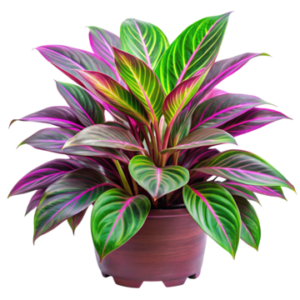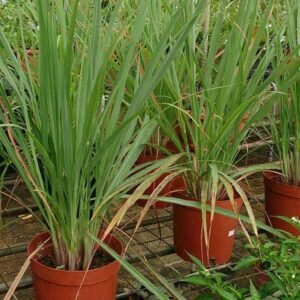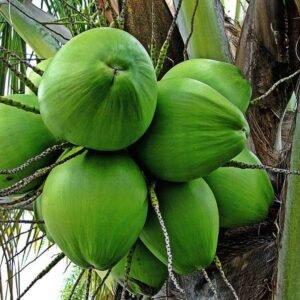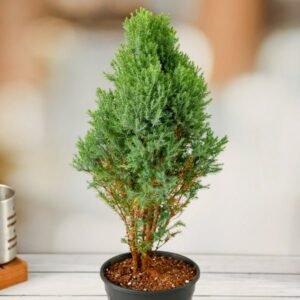Description
Lemon Croton Plant
The Lemon Croton plant (Codiaeum variegatum ‘Lemon’) is a striking and colorful tropical plant, known for its vibrant foliage, exotic appearance, and architectural value in gardens and interior spaces. A member of the Euphorbiaceae family, Crotons are native to Southeast Asia and the Pacific Islands. The ‘Lemon’ variety stands out among the many cultivars of Croton due to its unique coloration, foliage structure, and relatively moderate growth habit. It is popular in both tropical landscaping and indoor plant collections around the world.
Botanical Characteristics
The Lemon Croton is an evergreen perennial shrub that typically reaches a height of 2 to 4 feet indoors and up to 6 feet in outdoor tropical climates. Its defining feature is its foliage—large, leathery leaves that display an array of bright colors. In the ‘Lemon’ variety, the dominant shades include lime green, lemon yellow, and golden hues. These colors are often intermixed with deep green veins or blotches, creating a marbled or mottled appearance that adds to its decorative appeal.
The leaves are elongated, oval to lanceolate in shape, and slightly twisted or wavy along the edges. This physical twist not only enhances their visual interest but also helps the leaves catch light at different angles, making the plant shimmer with changing color intensity throughout the day.
New growth typically emerges in a brighter lemon-lime shade and matures to a more complex mixture of greens and yellows, often tinged with subtle bronze or reddish undertones. This dynamic coloration gives the plant a constantly evolving appearance that is highly valued by plant enthusiasts.
Growth Habits and Requirements
Lemon Croton, like all Croton plants, is a tropical species that thrives in warm, humid environments. It prefers temperatures between 65°F and 85°F (18°C to 29°C) and does not tolerate frost or cold drafts. It is ideally grown in USDA hardiness zones 10 to 12. Outside of these zones, it is often cultivated as a houseplant.
This cultivar prefers bright, indirect sunlight but can also handle some direct morning or late afternoon sun. Insufficient light can lead to duller foliage and leggy growth, while too much direct sun can cause leaf burn. When grown indoors, it should be placed near a south or east-facing window for best results.
Lemon Croton requires well-draining soil that retains moisture without becoming soggy. A peat-based potting mix with added perlite or sand is ideal. Watering should be consistent but moderate; the soil should be allowed to dry slightly between waterings. Overwatering can lead to root rot, while underwatering may result in leaf drop.
Humidity plays a crucial role in the plant’s health. As a tropical plant, it prefers a relative humidity of 50% or higher. In dry climates or during winter months indoors, regular misting, a pebble tray, or a humidifier can help maintain appropriate humidity levels.
Crotons are known to be slow growers, especially indoors. With proper care, the Lemon Croton will produce new leaves throughout the growing season, which usually lasts from spring to early autumn. During this period, feeding with a balanced liquid fertilizer every 4 to 6 weeks will support vibrant growth.
Uses and Aesthetic Appeal
The Lemon Croton plant is primarily grown for ornamental purposes. Its flamboyant foliage makes it a centerpiece in mixed planters, tropical-themed landscapes, or as a stand-alone houseplant. Outdoors, it is used in tropical garden beds, borders, or as a low hedge. Indoors, it is frequently used to add color and life to rooms with neutral decor, complementing modern and bohemian styles alike.
In commercial settings like hotel lobbies, spas, and malls, Lemon Croton is used for its visual impact and low maintenance requirements. It offers an exotic flair and requires less space than flowering plants while providing continuous color throughout the year.
Maintenance and Pruning
Lemon Crotons are relatively low-maintenance but benefit from occasional grooming. Pruning helps maintain their shape and encourages bushier growth. Leggy stems or sparse foliage can be trimmed back to the desired height, ideally in spring or early summer. Always use sterilized tools to prevent the spread of disease, and wear gloves—Crotons, being in the Euphorbiaceae family, release a milky sap that can be irritating to the skin and toxic if ingested.
Crotons are also sensitive to changes in environment. They may shed leaves when moved to a new location, especially if the light or humidity differs drastically. However, once acclimated, the plant generally rebounds well.
Pest and Disease Management
Though relatively hardy, Lemon Crotons are susceptible to common houseplant pests such as spider mites, mealybugs, aphids, and scale insects. Regular inspection of the leaves, especially the undersides, can help catch infestations early. Affected plants can be treated with insecticidal soap, neem oil, or by wiping leaves with a damp cloth.
Root rot, caused by overwatering or poorly draining soil, is one of the few diseases that can seriously impact a Croton. Ensuring proper watering habits and good airflow around the plant can mitigate this risk.
Propagation
Lemon Crotons can be propagated through stem cuttings. The best time for propagation is in spring or early summer. Cut a 4-6 inch stem with several leaves, allow the cut to dry briefly, and then place it in water or a moist propagation mix. Rooting can take several weeks, especially if humidity and temperature levels are not ideal. Using a rooting hormone can improve success rates.
Propagation is useful not only for multiplying plants but also for rejuvenating older or leggy specimens.
Toxicity and Pet Safety
It’s important to note that all Crotons, including the Lemon variety, are toxic to pets and humans if ingested. The plant contains compounds that can cause gastrointestinal discomfort, vomiting, and skin irritation. As such, it should be kept out of reach of children and pets.
Symbolism and Cultural Associations
In some cultures, Croton plants are considered symbols of good luck, strength, and protection. Their colorful appearance is often associated with vitality, energy, and positive change. In feng shui, their dynamic presence is believed to bring balance and brighten stagnant areas.
Conclusion
The Lemon Croton plant is a tropical gem that combines vibrant color, bold form, and a relatively low-maintenance care routine, making it a favorite among gardeners and indoor plant lovers alike. While it does require specific conditions to thrive—especially in terms of light, humidity, and temperature—those who can meet its needs are rewarded with a spectacular display of foliage that few other plants can match. Whether used as a statement piece in a modern apartment or as a colorful component in a tropical landscape, the Lemon Croton never fails to captivate with its radiant charm and lively character.





 GREEN CYPRUS-PLANT
GREEN CYPRUS-PLANT 

Reviews
There are no reviews yet.